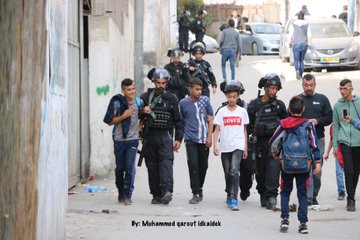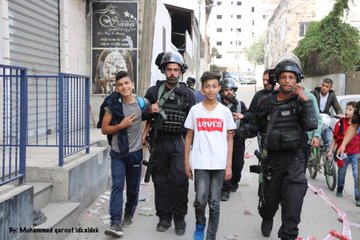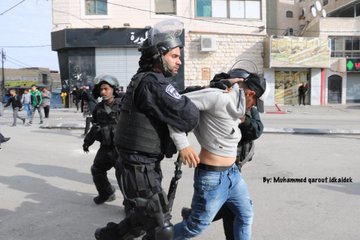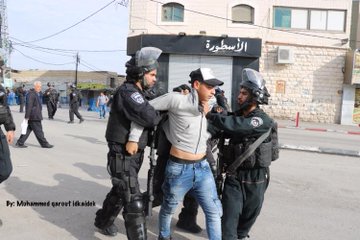A Brief Colonial History Of Ceylon(SriLanka)
Sri Lanka: One Island Two Nations
A Brief Colonial History Of Ceylon(SriLanka)
Sri Lanka: One Island Two Nations
(Full Story)
Search This Blog
Back to 500BC.
==========================
Thiranjala Weerasinghe sj.- One Island Two Nations
?????????????????????????????????????????????????Thursday, November 29, 2018
Israel tightens noose around East Jerusalem

The Israeli settlement of Pisgat Zeev in front of the Palestinian
Shuafat refugee camp on 27 April 2018. Israel is pressing on with land
confiscations and house demolitions in a bid to bring more Jewish
settlers into East Jerusalem and environs.
Oren ZivActiveStills
Israel took various steps this month to entrench its occupation of East Jerusalem.
From demolishing Palestinian structures to approving further expansion
of settlements, Israel continues to threaten Palestinian existence in
the heart of the city.
On 21 November, Israel’s high court gave the green light to evict 700 Palestinian residents of the Silwanneighborhood in occupied East Jerusalem from land they’ve lived on for decades.
The court denied an appeal filed by 104 Silwan residents in the Batan
al-Hawa area against a 2002 government decision to transfer ownership of
the homes of some 70 Palestinian families to three individuals closely
associated with Ateret Cohanim, a right-wing Israeli settler organization focused on taking Palestinian land in Jerusalem.
The transfer of ownership is made possible by the 1950 Absentee Property
Law, which allows Israel to seize land owned by displaced Palestinian
refugees, who fled or were expelled from their homes during and after
the Nakba, the 1948 ethnic cleansing of Palestinians carried out by Zionist forces to make room for an Israeli state.
Government collusion
Israel’s high court judges rejected the appeal despite knowing “that the
procedure concerning the Silwan village homes was flawed and raised
questions about land transfers to [Ateret Cohanim],” Israel’s i24 Newsreported.
Israeli human rights group B’Tselem condemned the
court’s decision, stating that it “gives its seal of approval to almost
any infringement of Palestinians’ rights by the Israeli authorities,”
adding that various government ministries have assisted Ateret Cohanim
in encroaching on Palestinian land in Batan al-Hawa and handing over
their homes to Jewish settlers.
Apart from the blatant theft of Palestinian land, the increased presence
of illegal settlers also necessitates a greater “security” presence for
them, creating an even more violent atmosphere for Palestinian
residents.
“The stronger the hold settlers have in the neighborhood of Batan
al-Hawa, the greater the number of Palestinians directly impacted by the
settler security apparatus, even without being expelled from their
homes,” B’Tselem added.
Demolishing storefronts
On 21 November, Israeli occupation forces demolished some 20 commercial buildings on a busy street in Jerusalem’s Shuafat refugee camp.
The Israeli press called it the “most significant” demolition since the construction of Israel’s apartheid wall in the occupied West Bank during the second intifada.
The demolition order came from the Jerusalem municipality, which rarely
grants Palestinians building licenses, forcing them to build “illegally”
and live in constant fear of demolition.
Local media circulated pictures of the operation on social media, dubbing it the “demolition massacre.”
This video shows Israeli forces conducting the demolition:
جانب من اقتحام قوات الاحتلال وتنفيذ #مجزرة_الهدم في مخيم شعفاط بالقدس المحتلة. pic.twitter.com/XO4uYgXg8n— شبكة قدس الإخبارية (@qudsn) 21 November 2018
Israeli forces also detained Palestinians during the operation, including three children:
قوات الاحتلال تعتقل شاب من مخيم شعفاط بالقدس المحتلة، وذلك خلال الحملة التي تقوم بها في المخيم من خلال هدم لمبان ومنشآت تجارية.
تصوير: محمد قاروط ادكيدك
Demolition warnings were given 12 hours prior to the act. Israeli forces
blocked off entrances into the camp and restricted movement in the area
on 21 November, and arrived again the day after to continue the
demolition.
EU concern
Maja Kocijancic, spokesperson for EU foreign policy chief Federica Mogherini, condemned Israel’s actions as jeopardizing a two-state solution.
“The European Union is strongly opposed to Israel’s settlement policy,
illegal under international law, and actions taken in that context, such
as forced transfers, evictions and demolitions,” she said in a
statement on 24 November.
“The EU expects the Israeli authorities to reconsider and reverse these decisions.”
She did not spell out clear consequences for Israel if it defies these
calls. In the past, the EU has done nothing to hold Israel accountable
for demolishing structures, including ones funded from EU coffers.
Twice displaced
Meanwhile, Israel’s high court has denied the appeal of a Palestinian
family who is being evicted from their East Jerusalem home.
The court refused to hear the Sabbagh family’s case on the building’s ownership in the Sheikh Jarrah neighborhood.
The family of 40 – 30 of which are children – will be thrown out within months and has nowhere else to live.
The Sabbagh family is originally from Jaffa and owns two homes there.
They fled following the Nakba and settled in Sheikh Jarrah in 1956.
After the Nakba, Israel took over the homes and properties Palestinians
fled under its Absentee Property Law, including those of the Sabbagh
family.
“Their two former houses in Jaffa still exist, and they keep pictures of them in their living room,” according to Israeli daily Haaretz.
The house that the Sabbagh family lives on in Sheikh Jarrah was owned by
Jewish individuals before the Nakba, but was abandoned during it.
The Jordanian government and the United Nations built housing on the
land for Palestinian refugees six years after the Nakba, and the Sabbagh
family moved into one of those buildings.
“We have two houses in Jaffa, on Hasneh Street and Hagidam Street, and
we have 250 dunams [62.5 acres] in Yavneh and also in Ashdod,” Muhammad
Sabbagh, 71, told Haaretz.
“Why can’t I ask for my property from before 1948?”
In 2003, a company registered in the United States, called Nahalat
Shimon International, bought the land from the Jewish groups that claim
to have owned it before 1948, and has been fighting to forcibly displace
Palestinians from there since then.
“The ruling will also make it very difficult for dozens of other Palestinian families in Sheikh Jarrah to avoid eviction,” Haaretz reported.
Settlement ring
Meanwhile, Israel’s parliament passed a law last week permitting the building of residential settlements atop public parks, according to Haaretz.
This would enable the construction of housing units in the City of
David archeological site near the al-Aqsa mosque in occupied Jerusalem.
The law’s bill was backed by Elad, a private organization that settles Jews in occupied East Jerusalem in violation of international law.
The Palestine Liberation Organization’s National Bureau for Defending Land said the
new law was part of an Israeli plan to establish a settlement ring
around the city of Jerusalem, in order to increase the number of
settlers there at the expense of Palestinian residents.
Earlier this month, the Jerusalem District Planning and Building
Committee approved the building of 640 new Israeli settlement homes in
Ramat Shlomo, a Jewish-only colony in East Jerusalem.
Some of the new homes will be built on privately owned Palestinian land, according to Haaretz.
Some 3,000 Israeli settlers live in Palestinian neighborhoods in
Jerusalem’s Old City and the surrounding area, amid some 100,000
Palestinians, according to B’Tselem.







